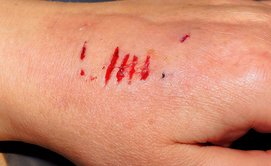Biting
|
Dogs have to learn to bite without injuring people or other dogs. In the dog training biz, this is called “Acquired Bite Inhibition.”
When puppies play with each other and with their moms, the other dogs give off signals to tell them they bit down too hard: they might yelp, growl, back away, or stop playing altogether. |
When the biting pup gets these messages enough times, he figures out that biting down hard makes the fun stop, so he learns to stop doing it.
But not all dogs have access to play with others when they are puppies. There’s some good news and some bad news because of this.
First the good news: You can teach your puppy to not bite down hard. We discuss this on our Puppies page, but basically you mark the moment when your dog bites too hard by saying in a non-threatening tone, “Ouch,” and then you immediately stop playing and walk away. You’re essentially giving the dog a “time-out” just as you would a child who is playing too rough. After enough repetitions of "Hard Bite = 'Ouch' = You Walk Away," your pup will eventually learn to soften his bite.
Now the bad news: There is no evidence that Acquired Bite Inhibition is something that an adult dog can learn — it must be taught when dogs are puppies. This means that if your adult dog bites too hard even when just playing, you’ll have to manage the environment so that no one gets hurt.
But not all dogs have access to play with others when they are puppies. There’s some good news and some bad news because of this.
First the good news: You can teach your puppy to not bite down hard. We discuss this on our Puppies page, but basically you mark the moment when your dog bites too hard by saying in a non-threatening tone, “Ouch,” and then you immediately stop playing and walk away. You’re essentially giving the dog a “time-out” just as you would a child who is playing too rough. After enough repetitions of "Hard Bite = 'Ouch' = You Walk Away," your pup will eventually learn to soften his bite.
Now the bad news: There is no evidence that Acquired Bite Inhibition is something that an adult dog can learn — it must be taught when dogs are puppies. This means that if your adult dog bites too hard even when just playing, you’ll have to manage the environment so that no one gets hurt.
Argue vs. Assault

Good bite inhibition is the difference between a dog who “argues” and one who “assaults.” The vast majority of dog bites are less injurious than a typical kitchen injury — they are resolved with no more than a Band-Aid and require no further intervention. These fall into the “arguing” category and are indicative of good bite inhibition. Knowledgeable trainers would say that an adult dog that routinely bites this way has a “good mouth.”
On the flip side, sometimes dogs do damage when they bite — damage that requires medical attention. Deep punctures that require antibiotics and lacerations that require sutures are indicative of poor bite inhibition and fall into the “assault” category mentioned above. Dogs who bite this way should be managed around triggers, either with the use of a muzzle or by completely restricting access.
On the flip side, sometimes dogs do damage when they bite — damage that requires medical attention. Deep punctures that require antibiotics and lacerations that require sutures are indicative of poor bite inhibition and fall into the “assault” category mentioned above. Dogs who bite this way should be managed around triggers, either with the use of a muzzle or by completely restricting access.

